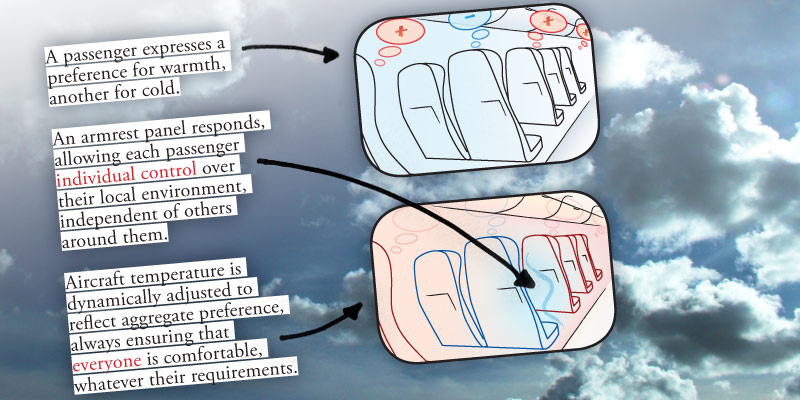
Design, etc

Customers are willing pay large premiums to bask in control over every detail afforded to them during their journey. The inflight menu offers an array of meal options, individual multimedia stations offer a selection of entertainment options, and local directional lighting is under their full command. Temperature, however, affects everybody on board equally, whether flying first class or economy; we share the air we breathe and the environmental temperature. Interviews with a range of air travellers - long and short haul, first, business, and economy - led to the identification of the lack of any effective control over this aspect of the travel experience as both a regular and repeated irritation.
Given the constraints of designing for air-travel, especially lack of space and the huge cost of carrying additonal weight, a service rather than a physical product seemed an appropriate response to the problem. The proposed system gives passengers control where an individual, physical bubble was impractical. Integrating only the additional options of 'warmer' or 'cooler' into existing armrest controls gives users influence over their environment in two ways: by giving an immediate, local, short term response, and by simultaneously influencing the collective environment to ensure that as many travellers as possible are comfortable with the overall ambient temperature at all times.
With only two relative options, warmer and cooler - although no action (ie, 'I'm happy with the current temperature') might be considered as a default third choice - everybody's requests would always be relative to the current temperature. If the preset temperature was perfect for everybody on board, nobody would want it warmer or cooler and it would remain at the preset; if it was only slightly off, however, only a few people would request a change in temperature. If the majority were unhappy, for example if the temperature had swung wildly one way or the other or they had just embarked from a cold airport, even the most tolerant passengers would feel a need to make a request for hotter or colder. This way, each passenger feels that the system is reponsive - becuase of the immediate local change - and the entire system would quickly stabilize at a temperature that reflects aggregate preferences. Regardless of the hidden complexity, the system is simple to use: a natural use of the wisdom of the crowds, where only each individual member of the crowd can know the (their) right answer.
Project carried out together with Boeing Europe and British Airways at Brunel.